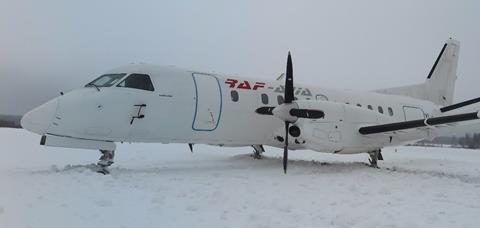Finnish investigators believe a RAF-Avia Saab 340B crew did not realise that the aircraft had drifted left of the centreline, over an area of banked snow on the edge of the runway, before it touched down at Savonlinna airport.
Runway 12 had been cleared to a width of 37m a few minutes before the aircraft’s arrival, following a ferry flight from Riga, on 7 January. Snow banks piled to 40cm lay 4m inside of the runway edge lights.
The aircraft conducted an ILS approach and was stable until the threshold. It crossed the threshold at 126kt, above its 120kt target, and the aircraft floated close to the runway surface for 6-7s – touching down 307m beyond the optimal landing point.
“At no time did the pilots consider aborting the approach or landing,” says Finland’s Safety Investigation Authority.
The aircraft drifted to the left and landed on a snow bank, the resulting drag effect on the left-hand main landing-gear causing the aircraft to yaw and skid sideways into the snow.

In the space of around 300m the turboprop decelerated from 109kt at touchdown to a full stop, coming to rest having spun 110° to the left. It sustained considerable damage to both propellers, lighting wiring, and nose-wheel tyres, and received dents and cracks to the fuselage. Snow was packed inside the left engine intake.
None of the three occupants – the two pilots and an engineer – was injured.
Investigators were “significantly hampered” by a lack of cockpit-voice recorder information, says the inquiry, because the device failed to record the flight and, in any case, previous recordings had been of poor quality.
The flight-data recorder contained sufficient information to derive the accident sequence, but the inquiry states that the device was over 30 years of age and had a worn tape resulting in defects in the data.
“No single factor explains the failed landing,” says the inquiry, pointing out that the crew had been operating under difficult conditions.
The approach was carried out in darkness – with the crew’s shift having started during the night – and there was a crosswind with blowing snow, which can cause illusions and disorientation.
“Flying low and level over the runway may have made it more difficult to precisely determine the position of the aircraft,” says the inquiry.
Night operations can stress older individuals, it says, noting that the captain was 61 years of age. It adds that the crew was operating under time pressure, with only a short interval before the next scheduled departure.



















